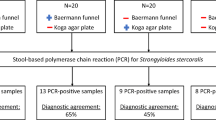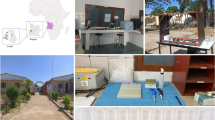Abstract
The intestinal protozoon Dientamoeba fragilis remains a clinical entity of dubious significance. While several previous studies address questions of epidemiology, only a handful have systematically employed and reported on the results from real-time polymerase chain reaction (qPCR), the best currently available diagnostic modality, and the comparison of results from different studies is, therefore, difficult. Since 2007, Statens Serum Institut (Denmark) has utilised qPCR for D. fragilis as routine diagnostic work-up for intestinal parasitosis, testing more than 22,000 samples from 2008 through 2011, and the aim of this study was to report on the results and experiences gained in the process. We demonstrate a staggeringly high proportion (43 %) of investigated patients positive for D. fragilis, ranging from 12 to 71 % depending on age group, showing a bimodal age distribution peaking in children and adults of parental age, as well as a clear association between exposure to children and risk of D. fragilis infection. We discuss these findings in light of the pinworm egg vector hypothesis and substantiate further our knowledge of risk factors pertaining to D. fragilis carriage.

Similar content being viewed by others
References
Banik GR, Barratt JL, Marriott D, Harkness J, Ellis JT, Stark D (2011) A case-controlled study of Dientamoeba fragilis infections in children. Parasitology 138(7):819–823
Barratt JL, Harkness J, Marriott D, Ellis JT, Stark D (2011) A review of Dientamoeba fragilis carriage in humans: several reasons why this organism should be considered in the diagnosis of gastrointestinal illness. Gut Microbes 2(1):3–12
Stark D, Barratt J, Roberts T, Marriott D, Harkness J, Ellis J (2010) A review of the clinical presentation of dientamoebiasis. Am J Trop Med Hyg 82(4):614–619
Vandenberg O, Souayah H, Mouchet F, Dediste A, van Gool T (2007) Treatment of Dientamoeba fragilis infection with paromomycin. Pediatr Infect Dis J 26(1):88–90
Keystone JS, Yang J, Grisdale D, Harrington M, Pillon L, Andreychuk R (1984) Intestinal parasites in metropolitan Toronto day-care centres. Can Med Assoc J 131(7):733–735
de Wit MA, Koopmans MP, Kortbeek LM, van Leeuwen NJ, Vinjé J, van Duynhoven YT (2001) Etiology of gastroenteritis in sentinel general practices in the Netherlands. Clin Infect Dis 33(3):280–288
Stensvold CR, Arendrup MC, Mølbak K, Nielsen HV (2007) The prevalence of Dientamoeba fragilis in patients with suspected enteroparasitic disease in a metropolitan area in Denmark. Clin Microbiol Infect 13(8):839–842
Stark D, Barratt J, Roberts T, Marriott D, Harkness J, Ellis J (2010) Comparison of microscopy, two xenic culture techniques, conventional and real-time PCR for the detection of Dientamoeba fragilis in clinical stool samples. Eur J Clin Microbiol Infect Dis 29(4):411–416
Stensvold CR, Nielsen HV (2012) Comparison of microscopy and PCR for detection of intestinal parasites in Danish patients supports an incentive for molecular screening platforms. J Clin Microbiol 50(2):540–541
Bart A, van der Heijden HM, Greve S, Speijer D, Landman WJ, van Gool T (2008) Intragenomic variation in the internal transcribed spacer 1 region of Dientamoeba fragilis as a molecular epidemiological marker. J Clin Microbiol 46(10):3270–3275
Barratt JL, Banik GR, Harkness J, Marriott D, Ellis JT, Stark D (2010) Newly defined conditions for the in vitro cultivation and cryopreservation of Dientamoeba fragilis: new techniques set to fast track molecular studies on this organism. Parasitology 137(13):1867–1878
King S, Chambers CT, Huguet A et al (2011) The epidemiology of chronic pain in children and adolescents revisited: a systematic review. Pain 152(12):2729–2738
Lovell RM, Ford AC (2012) Effect of gender on prevalence of irritable bowel syndrome in the community: systematic review and meta-analysis. Am J Gastroenterol 107(7):991–1000
Windsor JJ, Johnson EH (1999) Dientamoeba fragilis: the unflagellated human flagellate. Br J Biomed Sci 56(4):293–306
Johnson EH, Windsor JJ, Clark CG (2004) Emerging from obscurity: biological, clinical, and diagnostic aspects of Dientamoeba fragilis. Clin Microbiol Rev 17(3):553–570, table of contents
Vandenberg O, Peek R, Souayah H et al (2006) Clinical and microbiological features of dientamoebiasis in patients suspected of suffering from a parasitic gastrointestinal illness: a comparison of Dientamoeba fragilis and Giardia lamblia infections. Int J Infect Dis 10(3):255–261
Preiss U, Ockert G, Brömme S, Otto A (1990) Dientamoeba fragilis infection, a cause of gastrointestinal symptoms in childhood. Klin Padiatr 202(2):120–123
Kurt O, Girginkardeşler N, Balcioğlu IC, Ozbilgin A, Ok UZ (2008) A comparison of metronidazole and single-dose ornidazole for the treatment of dientamoebiasis. Clin Microbiol Infect 14(6):601–604
Schure JM, de Vries M, Weel JF, van Roon EN, Faber TE (2012) Symptoms and treatment of Dientamoeba fragilis infection in children, a retrospective study. Pediatr Infect Dis J 32(4):e148–e150
Röser D, Nejsum P, Carlsgart AJ, Nielsen HV, Stensvold CR (2013) DNA of Dientamoeba fragilis detected within surface-sterilized eggs of Enterobius vermicularis. Exp Parasitol 133(1):57–61
Andersen LO, Röser D, Nejsum P, Nielsen HV, Stensvold CR (2013) Is supplementary bead beating for DNA extraction from nematode eggs by use of the NucliSENS easyMag protocol necessary? J Clin Microbiol 51(4):1345–1347
Verweij JJ, Mulder B, Poell B, van Middelkoop D, Brienen EA, van Lieshout L (2007) Real-time PCR for the detection of Dientamoeba fragilis in fecal samples. Mol Cell Probes 21(5–6):400–404
Pedersen CB, Gøtzsche H, Møller JO, Mortensen PB (2006) The Danish Civil Registration System. A cohort of eight million persons. Dan Med Bull 53(4):441–449
Statistics Denmark (2012) Personal income 2008–2010
Harrell FE (2001) Regression modeling strategies: with applications to linear models, logistic regression, and survival analysis. Springer, New York
Ethelberg S, Simonsen J, Gerner-Smidt P, Olsen KE, Mølbak K (2005) Spatial distribution and registry-based case–control analysis of Campylobacter infections in Denmark, 1991–2001. Am J Epidemiol 162(10):1008–1015
Mantel N, Haenszel W (1959) Statistical aspects of the analysis of data from retrospective studies of disease. J Natl Cancer Inst 22(4):719–748
Petersen AM, Stensvold CR, Mirsepasi H et al (2013) Active ulcerative colitis associated with low prevalence of Blastocystis and Dientamoeba fragilis infection. Scand J Gastroenterol (in press)
Norberg A, Nord CE, Evengård B (2003) Dientamoeba fragilis—a protozoal infection which may cause severe bowel distress. Clin Microbiol Infect 9(1):65–68
Yang J, Scholten T (1977) Dientamoeba fragilis: a review with notes on its epidemiology, pathogenicity, mode of transmission, and diagnosis. Am J Trop Med Hyg 26(1):16–22
Grendon JH, DiGiacomo RF, Frost FJ (1995) Descriptive features of Dientamoeba fragilis infections. J Trop Med Hyg 98(5):309–315
Nachamkin I, Szymanski CM, Blaser MJ (2008) Campylobacter, 3rd edn. ASM Press, Washington DC
Glass RI, Becker S, Huq MI et al (1982) Endemic cholera in rural Bangladesh, 1966–1980. Am J Epidemiol 116(6):959–970
Anderson EJ, Weber SG (2004) Rotavirus infection in adults. Lancet Infect Dis 4(2):91–99
ten Hove R, Schuurman T, Kooistra M, Möller L, van Lieshout L, Verweij JJ (2007) Detection of diarrhoea-causing protozoa in general practice patients in The Netherlands by multiplex real-time PCR. Clin Microbiol Infect 13(10):1001–1007
Statistics Denmark (2012) Denmark in numbers 2012
Barratt JL, Harkness J, Marriott D, Ellis JT, Stark D (2011) The ambiguous life of Dientamoeba fragilis: the need to investigate current hypotheses on transmission. Parasitology 138(5):557–572
Burrows RB, Swerdlow MA (1956) Enterobius vermicularis as a probable vector of Dientamoeba fragilis. Am J Trop Med Hyg 5(2):258–265
Girginkardeşler N, Kurt O, Kilimcioğlu AA, Ok UZ (2008) Transmission of Dientamoeba fragilis: evaluation of the role of Enterobius vermicularis. Parasitol Int 57(1):72–75
Lacroix M, Sørensen B (2000) Occurrence of Enterobius vermicularis in children hospitalized at a central hospital. Ugeskr Laeger 162(9):1236–1238
Herrström P, Friström A, Karlsson A, Högstedt B (1997) Enterobius vermicularis and finger sucking in young Swedish children. Scand J Prim Health Care 15(3):146–148
Herrström P, Henricson KA, Råberg A, Karlsson A, Högstedt B (2001) Allergic disease and the infestation of Enterobius vermicularis in Swedish children 4–10 years of age. J Investig Allergol Clin Immunol 11(3):157–160
Bøås H, Tapia G, Sødahl JA, Rasmussen T, Rønningen KS (2012) Enterobius vermicularis and risk factors in healthy Norwegian children. Pediatr Infect Dis J 31(9):927–930
Remm M (2006) Distribution of enterobiasis among nursery school children in SE Estonia and of other helminthiases in Estonia. Parasitol Res 99(6):729–736
Nejsum P, Parker ED Jr, Frydenberg J et al (2005) Ascariasis is a zoonosis in Denmark. J Clin Microbiol 43(3):1142–1148
Cacciò SM, Sannella AR, Manuali E et al (2012) Pigs as natural hosts of Dientamoeba fragilis genotypes found in humans. Emerg Infect Dis 18(5):838–841
Sukanahaketu S (1977) The presence of Dientamoeba fragilis in the Ascaris lumbricoides ova: the first report from Thailand. J Med Assoc Thai 60(6):256–258
Financial support
None.
Conflict of interest
None.
Author information
Authors and Affiliations
Corresponding author
Rights and permissions
About this article
Cite this article
Röser, D., Simonsen, J., Nielsen, H.V. et al. Dientamoeba fragilis in Denmark: epidemiological experience derived from four years of routine real-time PCR. Eur J Clin Microbiol Infect Dis 32, 1303–1310 (2013). https://doi.org/10.1007/s10096-013-1880-2
Received:
Accepted:
Published:
Issue Date:
DOI: https://doi.org/10.1007/s10096-013-1880-2




